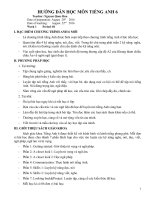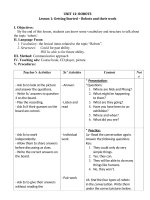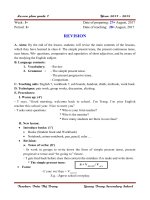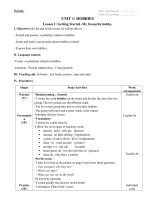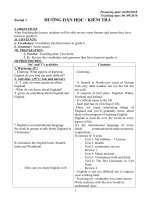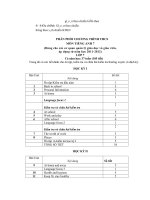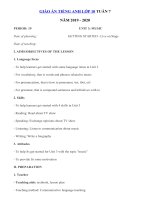Tieng Anh 7 Sach moi Giao an hoc ki 1
Bạn đang xem bản rút gọn của tài liệu. Xem và tải ngay bản đầy đủ của tài liệu tại đây (320.56 KB, 19 trang )
Week:
Period: 27
Date of planning: / /
Date of teaching: / /
UNIT 4: MUSIC AND ARTS
Lesson 1: Getting Started – Making plans for the weekend
I. Objectives:
1. Skills:
-Speaking skill: Talk about music and art
-Listening and reading skills: Listen and read for specific information about a
plan then say True or false/ gap fill
-Writing skill: Complete the sentences with the given words.
2. Knowledge
-For better understanding of arts and music: Content of the conversation
between Duong and Nick; vocabulary relating music and arts.
-Language practice:
+Vocabulary: Music and arts
+Grammar: Comparisons: (not) as ... as; too; the same as; different from
3. Attitude towards: Pay much attention to the lesson.
II. Language Focus:
1. Vocabulary: the lexical items related to the topic “Music and Arts”.
2. Structures: - Expressing agreement: too and either;
- Comparisons:
(not) as … as
the same as
different from
III. Method: Communicative approach
IV. Teaching ads: Course book, CD player, pictures.
V. Procedures:
Teacher’s Activities
Ss’ Activities
Content
Competence
- Write on the board:
“Music and Arts”.
- Ask Ss questions.
- Ask Ss questions about
the picture.
- T-Whole
class
- Answer
- Play the recording
- Listen and
(twice)
read
- Ask Ss to do this
- Pair-work
exercise in pairs.
- Check their answers and
give explanations if
necessary.
- Ask Ss to work
individually to fill in the
gaps in the sentences.
- Call some Ss to read
their answers.
- Individual
work
- Pair-work
- Tell Ss refer back to the
conversation to find the
phrases. Have Ss practice
saying them together.
-Explain the meaning to
Ss, then give some
examples.
- Pair-work
- Ask Ss to practice the
conversations in pairs
before creating their
short role-plays.
* Presentation:
Questions:
Do you often listen to
music? When? How often?
What kind of music do you
like? Why?
Questions:
Who are Duong and Nick?
What are they going to do?
* Practice:
1. Listen and read
a. Are these sentences true
(T) or false (F)?
Key:
1. T
2. F 3. T
4. F
5. F
b. Finish the following
sentences
Key:
1. as good as
2. loud
3. fantastic
4. in person
5. cinema
c. Find these sentences in the
conversation. Check what
they mean.
Key:
1. Use when you are
thinking what to say or
reply.
2. Use to show that you
don’t agree with what
sb has said.
3. Use to show that you
don’t like something.
d. Work in pairs. Make short
role-plays with the
expressions above.
Example:
A: We’ll go to the cinema
Communicatin
g
Listening and
reading
- Individual
work
- Ask Ss to write the
words/ phrases under the
right pictures. Then play
the recording.
- Let Ss listen and repeat.
- Check and correct their
pronunciation.
- Give Ss the meaning of
words if necessary.
- Ask Ss to give their
partner the directions to
one of the places on the
map, and they try to
guess. Then swap.
- Pair-work
next Saturday. Can you go,
too?
B: Let’s me see. I’ll have to
ask my parents first.
2. Write the correct word/
phrase under each of the
pictures.
Key:
1. Microphone
2. Camera
3. Painting
4. Musical instruments
5. Portrait
6. Art gallery
7. Crayons
8. Museum
9. Opera
10.Paintbrush
* Production:
3. Complete these sentences
with words from 2.
Key:
1. Art gallery
2. Paintings
3. Museum
4. Camera
5. Opera
*Homework:
- Prepare the next lesson
(A closer look 1)
Listening and
writing
Writing
Week:
Period: 28
Date of planning:
Date of teaching:
/
/ /
/
UNIT 4: MUSIC AND ARTS
Lesson 2: A Closer Look 1
I. Objectives:
1. Skills:
- Speaking skill: talking about music and arts.
- Listening skill: listen and repeat the words, practice the sounds: /ʃ/, /Ʒ/.
- Writing skill: complete the sentences with the given words
2. Knowledge
- For better understanding of lexical items related to music and arts
3. Attitude towards: Pay attention to the lesson.
II. Language Focus:
1. Vocabulary: the lexical items related to the topic “Music and Arts”.
2. Structures: - Expressing agreement: too and either;
- Comparisons:
(not) as … as
the same as
different from
III. Method: Communicative approach
Teacher’s Activities
Ss’ Activities
Content
* Presentation:
Vocabulary
- Brainstorm: find the words
- Brainstorm with Ss: let
- T-whole
related to music and arts.
them find all the words
class
1. Listen and repeat these
they know related to
words.
music and arts.
painter artist actress
- Play the recording and
musician puppet dancer
let Ss listen. Play again
singer song writer
with pause for Ss to
repeat each word.
- Correct their
2. Match a word in A with a
pronunciation.
- Individual
phrase in B.
work
* Practice:
3a. Put these letters in order to
- Ask Ss to work in pairs
- Pair-work
make musical instruments.
and put the letters in
Competence
Listening
Working in
pair
- Ask Ss to work in pairs
and put the letters in
order to form the correct
words.
- Check their answers.
- Pair-work
- Pair-work
- Let Ss work in pairs then
check their answers.
- Ask Ss to read the words
after T. Let them talk
about these musical
instruments.
- Individual
work
- Ask Ss to put one of
these words in each blank
to finish the sentences.
- Call some Ss to write
their answers on the
board.
- Let the class comment
and give them the correct - T- whole
answers.
class
- Let Ss practice the sound
/ʃ/ and /ʒ/ together.
Show Ss how to
pronounce the two
sounds. Play the
recording and let Ss listen
and repeat.
- Play the recording twice
* Practice:
3a. Put these letters in order to
make musical instruments.
Key:
1. drum
2. piano
3. cello
4. guitar
5. violin
6. saxophone
3b. Write the type of musical
instruments in the box under
each picture.
Key:
1. a guitar
2. a drum
3. Dan Bau (one string
guitar)
4. a violin
5. a cello
6. a piano
7. a saxophone
4. Put one of these words in
each blank to finish the
sentences.
Key:
1. Painter
2. Pop
3. Singer
4. Draw
5. Puppet
6. Instrument
Pronunciation /ʃ/ and /ʒ/
5. Listen and repeat the words.
Pay attention the sound /ʃ/
and /ʒ/
6. Listen to the words and put
them into two groups.
Key:
/ʒ/
/ʃ/
Anxious,
Closure,
Musician,
occasion,
dishwasher,
leisure,
rubbish.
television.
Working in
pair
Pronunciatin
g
or three times. Help Ss
distinguish the two
sounds, and put the
words in the right
columns.
- Play the recording as
many times as possible
and let Ss repeat the
sentences. Correct their
pronunciation and help
them do the task as
directed.
Week:
Period: 29
- Individual
work
Listening
* Production:
7. Listen and repeat the
sentences. Underline the words
with the sound /ʃ/ once.
Underline the words with the
sound /ʒ/ twice.
Key:
1. show, machine
2. occasions
3. musician, anxious
4. share, pleasure
5. station
6. sure, television
*Homework:
- Learn vocabulary by heart.
- Prepare the next lesson
(A closer look
2)
Date of planning: ……/……/……
Date of teaching: ……/……/……
UNIT 4: MUSIC AND ARTS
Lesson 3: A Closer Look 2
I. Objectives:
1. Skills:
- Language practice: SS practice sentences with comparison: as... as, the same as, different
from.
- Writing skill: sentences with too and either
- Group work, pair work
2. Knowledge: For better understanding of comparing 2 people/ things.
-Vocabulary: Review the words relate to the topic Art and Music
-Grammar: Use comparisons: as... as, the same as, different from.
- Write sentences with too and either
3. Attitude towards: Pay much attention to the lesson.
.
II. Language Focus:
1. Vocabulary: the lexical items related to the topic “Music and Arts”.
2. Structures: Comparisons: (not) as … as; the same as; different from.
III. Method: Communicative approach
IV. Teaching ads: Course book, CD player, pictures.
V. Procedures:
Teacher’s Activities
Ss’ Activities
- Different types of
comparisons and
vocabulary related to them
were already studied in
Tieng Anh 5 and Tieng Anh
6.
- Ask Ss to recall what they
know and give examples.
- Explain the uses of three
- T-whole
class
- Let ss work by themselves
and write down the missing
words.
- Ask some Ss to read the
sentences.
- Correct Ss’ mistakes.
- Individual
work
- Let Ss do the task
individually. First read the
text, then put a suitable
word/ phrase in each gap,
and compare their answers
with a classmate.
- Correct Ss’ answers.
- Let Ss read in chorus.
- Individual
work
Content
* Presentation:
Grammar
Comparisons: (not) as … as;
the same as; different from.
- Example:
Classical music is not as
exciting as rock and roll.
The price of food is the same
as it was last year.
City life is quite different
from life in the country.
* Practice:
1. Put as, or from in the gaps.
Key:
1. as
2. as
3. as
4. from 5. as
6. as
2. Put one of these phrases in
each gap in the passage.
Key:
1. the same as
2. as quite as
3. different from
4. as narrow as
5. friendly as
6. the same as
Competenc
e
Writing
Writing
Correct their pronunciation
and intonation.
- Let Ss work in pairs. Help
them interpret the table
first. Give them instructions
on how to do the task.
- While Ss do their task, T
goes around to monitor the
class.
- Pair-work
- T Whole
class
- Explain to the class the use
and location in the
sentence of too and either.
- Let them read examples.
Tell them to give sentences - Individual
of their own.
work
- Group-work
- Ask Ss to work individually,
writing down the answers.
- Let Ss work in groups to
check and read the
sentences.
- Individual
work
Too and either
Examples:
A: I like pop music.
B: I like it too.
A: My mum doesn’t like rock
and roll.
B; My mum doesn’t like it
either.
4. Complete the following
sentences with “too” or
“either”.
Key:
1. Too
2. Either
3. Either
4. Too
5. Too
5. What music and arts are you
interested, or not interested in?
Make a list by completing the
sentences below.
- Let ss work individually,
writing down the answers
to make a list of the likes
and dislikes. They have their
own choices, so long as
their sentences are correct
grammatically. Encourage
them to give their own
ideas.
- Ask Ss to work in pairs to
share their lists of ideas.
3. Work in pairs. Compare the
two music clubs in the town:
Young Talent and Nightingale.
Example:
Young Talent is not as old
as Nightingale.
Nightingale is older than
Young Talent.
- Pair-work
* Production:
6. Work in pairs. Share your list
with your partner. Then, report
Writing and
speaking
- Ask some more Ss ro
report their results to the
class.
to the class using too/ either.
Example:
A: Nam is interested in drawing
and I am too.
B: Phong doesn’t like folk music
and I don’t either.
*Homework:
- Prepare the next lesson
Communication
Week:
Period: 30
Date of planning: / /
Date of teaching: / /
UNIT 4: MY NEIGHBOURHOOD
Lesson 4: Communication
I. Objectives:
1. Skills:
- Speaking skills: Talking about actors/actresses/ painters... they know.
- Group work skills: Pair work. group work
2. Knowledge: For better understanding of music and arts
- Language practice: Extra vocabulary: composer, originate, anthem, curriculum,
compulsory, academic, unimportant.
-Grammar:
3. Attitude towards: Pay much attention to the lesson.
II. Language Focus:
1. Vocabulary: the lexical items related to the topic “Music and arts”.
2. Structures: Present simple tense
III. Method: Communicative approach
IV. Teaching ads: Course book, CD player.
V. Procedures:
Teacher’s Activities
Ss’ Activities
Content
Competenc
e
- Brainstorm with Ss to give - T Whole
the names of famous
class
musicians, actors,
actresses, painter, and
music bands they know.
- Have Ss read the new
vocabulary after the
teacher. Explain the
meaning of the words to Ss.
- Ask Ss to work in groups
and find the answers.
- Give the correct answers.
- Group-work
- Give ss plenty of time to
work independently, read
the passage, and
understand the main ideas.
- Divide the class into
groups of four or five to
discuss the questions.
- After some time, elicit
ideas from the groups.
Then one student from
each group presents their
ideas to class.
- Group-work
- Have Ss work in groups of
four to six to make a list
from the most useful to
Speaking
* Presentation:
and writing
Extra vocabulary:
o Composer
o Originate
o Anthem
o Curriculum
o Compulsory
o Academic
o Unimportant
- What do you know about Hoi
An?
Working in
* Practice:
group
1. Music quiz: What do you
know?
Work in groups and answer
the questions.
Key:
1. B
2. C
3. A
4. C
5. B
6. B
2. Read the following passage.
In groups, discuss the
questions below.
Do you think music and arts
should be compulsory subjects
at schools in Viet Nam?
- Whole class
* Production:
3. Look at the different
subjects below. In groups,
make a list from the most
Discussing
least useful subjects given.
- After discussion, each
group presents their list,
and give a talk to the class.
- Give comments.
useful to the least useful in the
space below. How can the top
three subjects on your list help
you in other areas of school
and life?
Music
Dancing
Singing
Painting
photography
*Homework:
- Prepare the next lesson:
(Skills 1)
Week:
Date of planning: ……/……/……
Date of teaching: ……/……/……
Period: 31
UNIT 4: MUSIC AND ARTS
Lesson 5: Skills 1
I. Objectives:
1. Skills:
- Reading and speaking skills.
- SS know more types of music
- Group work skills: individually, pairs.
2. Knowledge:
-For better understand of types of arts
-Ss can read for specific information one kind of typical art in Viet Nam: water puppetry.
- Vocabulary: water puppetry, perform, performance, string, control, puppeteer, rural, theme
3. Attitude towards: Love/ be proud of our country.
II. Language Focus
1. Vocabulary: the lexical items related to the topic “Music and arts”.
2. Structures: - Expressing agreement: too and either;
- Comparisons:
(not) as … as
the same as
different from
III. Method: Communicative approach
IV. Teaching ads: Course book, CD player, flashcards.
V. Procedures:
Teacher’s Activities
- Ask Ss to name the art
forms they know. Ask Ss
work in pairs to discuss the
questions given.
- Tell Ss to read the text
three times. Set a strict
time limit to ensure Ss read
quickly for specific
information.
Ss’ Activities
- Pair-work
Content
* Presentation:
Reading
Discuss the questions below
with a partner.
- What kinds of traditional
Vietnamese performance do
you know about?
- Do you know about water
puppetry? Have you been to a
water puppet show? If yes, did
you like it? Why/ Why not?
Competenc
e
Speaking
- Ask Ss to work individually - Individual
to find the words.
work
- Call on some Ss to say the
words or write them on the
board.
- Give correction.
- Pair-work
- Ask Ss to read the passage
again and answer the
questions.
- Call on some individuals
to read aloud to the class.
- Check their pronunciation
and intonation. Explain the
new words and clarify
anything difficult.
- Pair-work
- Ask Ss to work in pairs and
do the matching.
- Allow Ss some time to talk
about their favorite kind of
music.
- Explain the rules of the
game Tic tac Toe to Ss.
- Have Ss work in pairs.
Decide which partner is X,
which is O and who will go
first. The first player
chooses a box and calls out
a number.
- Pair -work
* Practice:
1. Find the words in the text
which mean:
Key:
1. unique
2. began
3. performed
4. rural
5. festivals
Writing
2. Answer the following
questions.
Key:
1. It began in the 11th
century.
2. It takes place in a pool.
3. They are controlled by
puppeteers.
4. They are made of wood.
5. They are about
everyday life in the
countryside an about
folk tales.
Speaking
3. Match the types of music in
A with the adjectives to
describe them in B
Key:
1. E
2. A
3. B
4. C
5. D
* Production:
4. Game: TIC TAC TOE
With a partner, draw a tic tac
toe board, like the one below.
Then, write numbers 1 to 9 in
the boxes. You can put the
numbers anywhere you like!
Example:
Player 1: I want number 2.
Playing
games
Player 2: Ok, sing a song in
English!
*Homework:
- Prepare the next lesson:
(Skills 2)
Week: …
Period: 32
Date of planning: ……/……/……
Date of teaching: ……/……/……
UNIT 4: MUSIC AND ARTS
Lesson 6: Skills 2
I. Objectives:
1. Skills:
- Listening skills: Listen for specific information: Listen about Picasso then take
Competences (the keywords)
- Writing skill: Write an informal letter of invitation
- Language practice: Vocabulary: Music and arts
Grammar: Listening tip: Life of Picasso and writing tip: An informal
letter of invitation.
2. Knowledge: For better understanding of using lexical items related to the topic.
3. Attitude towards: Behave politely.
II. Language Focus
1. Vocabulary: the lexical items related to the topic “Music and arts”.
2. Structures: - Expressing agreement: too and either;
- Comparisons:
(not) as … as
the same as
different from
III. Method: Communicative approach
IV. Teaching ads: Course book, CD player
V. Procedures:
Teacher’s Activities
Ss’ Activities
Content
Competenc
* Presentation:
Listening
- Explain Listening Tip to Ss.
Tell them if they are going
to apply the listening tip,
then they must be given
time to take Competences.
- Ask Ss to look at the
picture and say what they
know about Picasso.
- T whole
class.
- Ask Ss to close their books.
Tell Ss they should listen
and Competence down the
keywords in their Note
books.
- Play the listening twice
and ask Ss to circle the
words they hear in the
passage.
- Check their
comprehension of choose
words.
- Individual
work
- Play the recording again.
While listen, Ss have to
choose A, B, C or D for their
answers.
- Play the recording again
once more. As a class, Have
Ss discuss how the listening
is organized (according to
timeline, the order of
important events, or
another way).
- Ask Ss why they would
write an informal letter of
- Individual
work
- Individual
work
e
listening
Listening Tip
When you listen, it is very
useful to take notes. Try to
note down the keywords.
This helps you to remember
the main ideas.
* Practice:
1. Listen to the passage about
Picasso and circle the words
you hear.
Key:
1.Artist
2. Training
4. Portrait
6. paintings
Listening
2. Listen to the passage again
and choose the correct
answers.
Key:
1. A
2. B
3. A
4. C
3. Listen to the passage once
more time. As a class, discuss
how the listening is
organized.
Writing
- Individual
work
Writing
Informal letter of invitation
4. Read the following letter
and choose the correct
answer.
Key:
1. A
2. B
invitation. Then focus their
attention on the Writing tip.
- Have Ss read the sample
letter carefully, and
Competence down the
useful expressions for
writing an informal letter of
invitation.
- Ask Ss read the cues
carefully, then practice
writing the letter. Tell Ss to
pay attention to spelling
and punctuation.
- Collect som Ss’ writing
papers and mark them,
then give comments to the
class.
- Ask Ss to write their own
letter as homework.
Week: …
Period:33
Writing tip
When you write an informal
letter of invitation, you use:
- How about + V-ing?
- Individual
work
* Production:
5. Now write a letter to invite
a friend to an art exhibition,
using the following cues
Event: Exhibition of
Modern Art
Time: 9 o’clock, Saturday
morning.
Place: Art Center.
Time to meet: 8.15
*Homework:
- Write the letter in your Note
book.
- Prepare the next lesson:
(Looking back)
Date of planning: ……/……/……
Date of teaching: ……/……/……
UNIT 4: MUSIC AND ARTS
Lesson 7: Looking Back
I. Objectives:
1. Skills:
Writing
- Writing skills: Use the words about arts and music to match and complete the
passage and the sentences, rewrite the sentences
- Speaking skills: Ask and answer about music and arts
-Group work skills: Work in pairs, work individually.
2. Knowledge
- For better understanding of music and arts.
- Language practice: Vocabulary about music and arts
Grammar: Comparisons; too; either
3. Attitude towards: Pay attention to the lesson.
II. Language Focus
1. Vocabulary: the lexical items related to the topic “Music and arts”.
2. Structures: - Expressing agreement: too and either;
- Comparisons:
(not) as … as
the same as
different from
III. Method: Communicative approach
IV. Teaching ads: Course book, CD player, pictures.
V. Procedures:
Teacher’s Activities
- Encourage Ss not to refer
back to the unit pages.
Instead they can use what
they have learnt during the
unit to help them answer
the question.
- Ask Ss to work
individually to match the
Ss’ Activities
- T whole
class
- Individual
work
- Ask Ss to work in pairs
- Pair-work
and write their answers in
their Note books.
- Correct the mistakes.
- Let Ss read the passage in
chorus or individually.
Content
Competenc
e
Writing
* Presentation:
Vocabulary
1. Match the words in column A
with the one in the column B.
Key:
1. e
2. c
3. b
4. a
5. d
* Practice:
Working in
2. Put the word from the box in
pair
each gap to complete the
passage.
Key:
1. music
2. arts
3. stages
4. go
5. films
- Have ss work in groups to - Groupwrite the answers. Check
work
their answers.
- Have Ss work individually
first to write the
sentences.
- Then ask them to work in
pairs to swap their
sentences.
- Give correction and calls
some Ss to read the
sentences aloud.
- Individual
work
- Pair-work
- Individual
work
- Have ss work individually.
Ask them check their
answer with a partner.
- Ask Ss read the questions
and answers twice. Then
- Pair-work
Grammar
3. Put the words/ phrases from
the box in the gaps to complete
the sentences.
Key:
1. art gallery
2. artistic
3. films
4. in person
5. sung
4. Rewrite these sentences,
using the words in brackets.
Key:
1. The photograph is not big as
the painting.
2. My painting is not as
expensive as this painting.
3. This picture is not different
from the picture in our
room.
4. The film we saw last week
is not as interesting as this
one.
5. The journey was not as long
as we thought as first.
5. Complete the following
sentences, using “too” or
“either”.
Key:
1. Too
2. Either
3. Either
4. Too
5. Too
* Production:
Communication
6. Match the questions 1-6 with
the answers A-F.
Speaking
match them.
- Let Ss work in pairs and
role-play the questions
and answers, then write all
the sentences in their Note
books.
Key:
1. B
2. A
3. E
4. C
5. D
6. F
*Homework:
- Do the PROJECT:
Dong Ho Painting
- Prepare next lesson: Unit 5
Getting started


